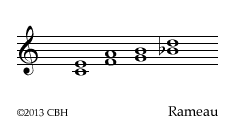Technical Library
TEMPERAMENTS XII: Rameau
Entire Contents Copyright © 2020 CBHTechnical LibraryTEMPERAMENTS XII: Rameau Entire Contents Copyright © 2020 CBH |
 WIKIMEDIA COMMONS / PUBLIC DOMAIN |
| Jean-Philippe Rameau (1683–1764) |

While Corrette’s
temperament reduced the huge wolf of Quarter-comma meantone by about half, a wolf is still a wolf. If we are willing, however, to make do with four pure Major thirds instead of Corrette’s five, there are many possible placements for the remaining notes of the circle.
One of the greatest French composers for the harpsichord was, of course, Jean-Philippe Rameau (1683–1764). Almost all of his solo harpsichord output came from relatively early in his life. Later, he became consumed—and even more famous—for his operas and theoretical writings. In his 1726 Nouveau Systeme de Musique Theorique, he described his preferred temperament, clearly based on the old meantone with a chain of seven Quarter-comma narrow fifths in a row, and the wolf divided in two.
William Christie wanted this temperament for his musical direction of Rameau’s opera Hippolyte et Aricie with Orchestra of the Age of Enlightenment at Glyndebourne. I was in London at the time of the first orchestral calls in early June 2013 visiting my friend and colleague, tuner extraordinaire Malcolm Greenhalgh, so we were able to discuss it at length.
Note from the diagram that Rameau is characterized by the C–E pure third with its enclosed four Quarter-comma fifths, which also extend on the flat and sharp side of these limits to make a total of seven Quarter-comma fifths. These result in four pure thirds shown in the notation below. There is one less-tempered fifth tucked between C♯ and G♯, two pure fifths, and the remaining error divided leaving two very wide fifths.
Other modern commentators have interpreted Rameau’s instructions according to their own beliefs, one even making the old Meantone fifths a different size and having no pure fifths at all. With temperaments, it seems, anything goes.
It will be relatively easy for us to again rework our Quarter-comma meantone base to change it to Rameau, modifying only four accidentals. Proceed as follows:
1. Raise your f♯' to make a pure fifth above b. Tune down an octave to f♯ then raise your c♯' to make a pure fifth above that. Tune down an octave to c♯.
 2. Your meantone G♯ must now be raised from the pure third it is presently making with E. Raise your g♯, roughening the e–g♯ interval. It’s unlikely you will go too far without becoming disturbed by the sound of this now rapidly-beating third. Check the g♯ constantly against your c♯: This fifth must remain narrow. Your g♯ is about right when the c♯–g♯ fifth beats once per second. For convenience, tune down an octave to G♯.
2. Your meantone G♯ must now be raised from the pure third it is presently making with E. Raise your g♯, roughening the e–g♯ interval. It’s unlikely you will go too far without becoming disturbed by the sound of this now rapidly-beating third. Check the g♯ constantly against your c♯: This fifth must remain narrow. Your g♯ is about right when the c♯–g♯ fifth beats once per second. For convenience, tune down an octave to G♯.
3. Looking at the circle of fifths diagram above, you can see you must now finally determine your D♯/E♭ to give you the two equally-wide fifths. Flatten your e♭ to split the difference between b♭ and G♯, making each of these fifths equally rough. (Bear in mind that if these two intervals are supposed to be the same theoretical size, your e♭–b♭ is going to beat just that more faster than G♯–e♭ (really G♯–d♯) and trick you into thinking you have actually tuned it rougher: Every octave you go up doubles the beat speed.)
While we may have split the wolf with this temperament, Rameau’s two wide fifths are still rather wide. Let’s see if we can tone them down some more with Marpourg.
To tune Rameau from scratch, follow these steps:
1. Tune a' to your pitch source, and tune a an absolute pure octave below it.
2. Tune a pure f–a third, and divide it into four quarter-comma narrow fifths, making f–c', g–d', c'–g' and d'–a' sound equally rough.
3. Three more pure thirds are determined from notes you have already tuned: Tune b a pure third above g; b♭ below d'; and e' above c'.
4. Tune your f♯' a pure fifth above b, and drop it down an octave to f♯.
5. Tune c♯' a pure fifth above f♯ and drop down an octave to c♯.
6. Tune g♯ pure to c♯ and lower it until c♯–g♯ fifth beats once per second. Drop down an octave to G♯.
7. Temporarily tune e♭ pure to b♭, then flatten your e♭ to split the difference between b♭ and G♯, making each of these wide fifths equally rough.
| Pitch nomenclature | |
| Harpsichord Tuning Process | |
| Tuning Bibliography | |
| Technical Library overview | |
| Harpsichords Australia Home Page |